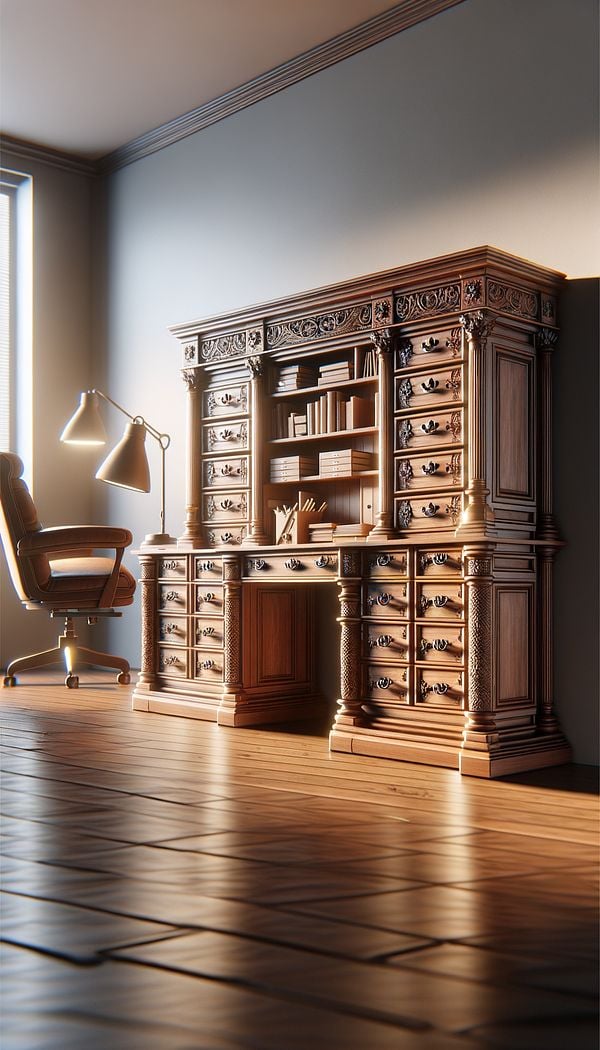What is a Bureau?
A bureau is a type of desk, typically featuring a flat surface for writing and numerous drawers for storage.
Description
A bureau is an indispensable piece of furniture that combines the features of a desk and a dresser. It's characterized by its flat surface used primarily for writing or placing a laptop, accompanied by several drawers situated below this surface. These drawers provide ample storage for a variety of items, such as office supplies, documents, and personal belongings, making the bureau a multifunctional piece of furniture ideal for both office and home environments.
Bureaus originated in France in the late 17th century and quickly became a staple in homes across Europe. The term 'bureau' itself is derived from the French word for 'office', reflecting the piece's functionality in providing a space for writing and organizing documents. Over the years, the design of bureaus has evolved, ranging from the ornate, highly decorative styles of the Baroque and Rococo periods to the sleek, minimalistic designs favored in contemporary interiors.
Today, bureaus are available in a wide range of styles, materials, and sizes, catering to diverse tastes and needs. They are commonly used in living rooms, bedrooms, and home offices, serving not only as a workspace but also as a significant element of the room's décor.
Usage
In a traditional home office, a beautifully crafted wooden bureau can serve as the centerpiece, offering both functionality for work-related tasks and elegance that enhances the room's aesthetics. For a more modern setup, a minimalist bureau with clean lines and a sleek finish can complement a contemporary interior design, providing a practical working space while maintaining the room's streamlined look. In bedrooms, smaller bureaus offer a solution for compact spaces, doubling as a desk and a storage unit.
FAQs
-
What differentiates a bureau from a regular desk?
The main difference between a bureau and a regular desk lies in the bureau's additional storage capabilities. A bureau typically features numerous drawers for organizing and storing various items, while a regular desk may have a simpler design focused primarily on providing a work surface.
-
Can a bureau be used in non-office environments?
Absolutely. Bureaus are versatile pieces of furniture that can be used in living rooms, bedrooms, and even dining areas, acting as a work surface or a storage solution. Their elegant design and functionality make them suitable for various settings beyond the traditional office space.
-
How can I choose the right bureau for my space?
When choosing a bureau, consider the size of the room, your storage needs, and the overall design theme. Opt for a bureau that complements your interior design style, fits comfortably within your space, and offers enough storage for your needs. Material and finish are also important considerations for ensuring the bureau coordinates well with your other furniture.
Practical Application
When integrating a bureau into your interior design, position it in a location that benefits from natural light, ensuring a comfortable workspace. Consider the bureau's height and chair ergonomics to promote a healthy posture. Additionally, utilize the drawers to keep your work environment clutter-free, categorizing items for easy access. Accessorizing the bureau's surface with a lamp, a small plant, or decorative objects can add a personal touch and enhance the overall look of your space.
-
Bungalow StyleBungalow Style refers to a compact, single-story house design with distinct architectural features.
-
ModernModern is an interior design style that emphasizes clean lines, minimalism, and the use of new materials.
-
Club SofaA club sofa is a plush, upholstered sofa with a low back and deep seats, characterized by its comfortable and inviting design.
-
Rococo RevivalRococo Revival is a 19th-century furniture and interior design style that draws inspiration from the 18th-century French Rococo period.
-
ChesserA chesser is a piece of furniture that combines elements of a chest of drawers and a dresser.
